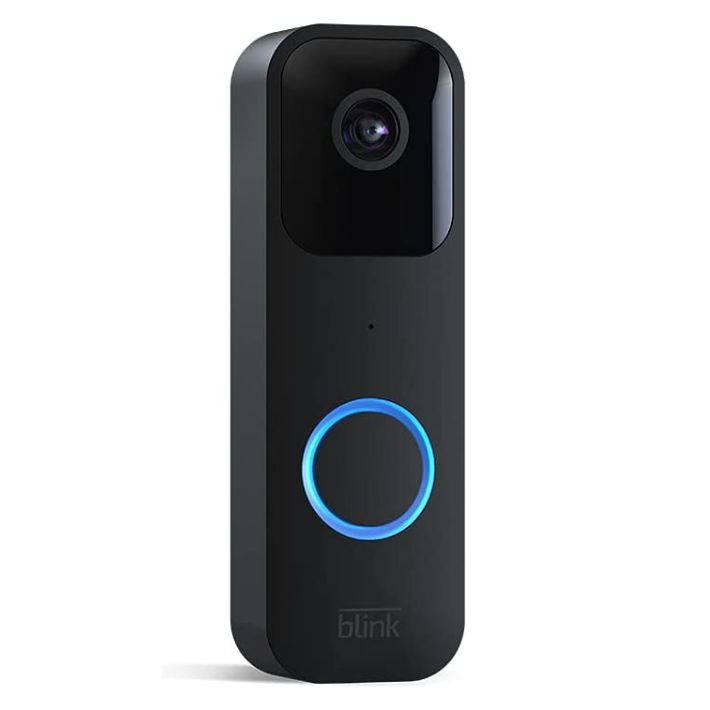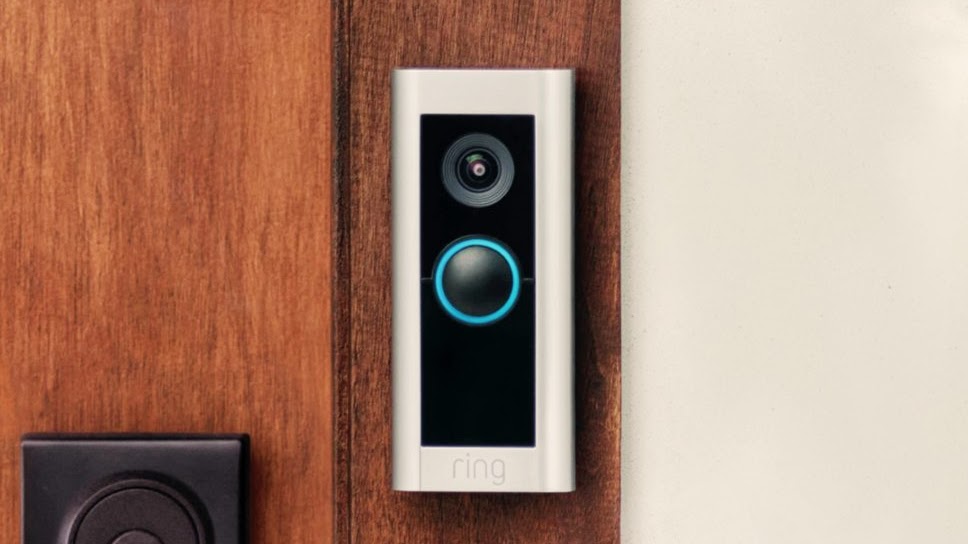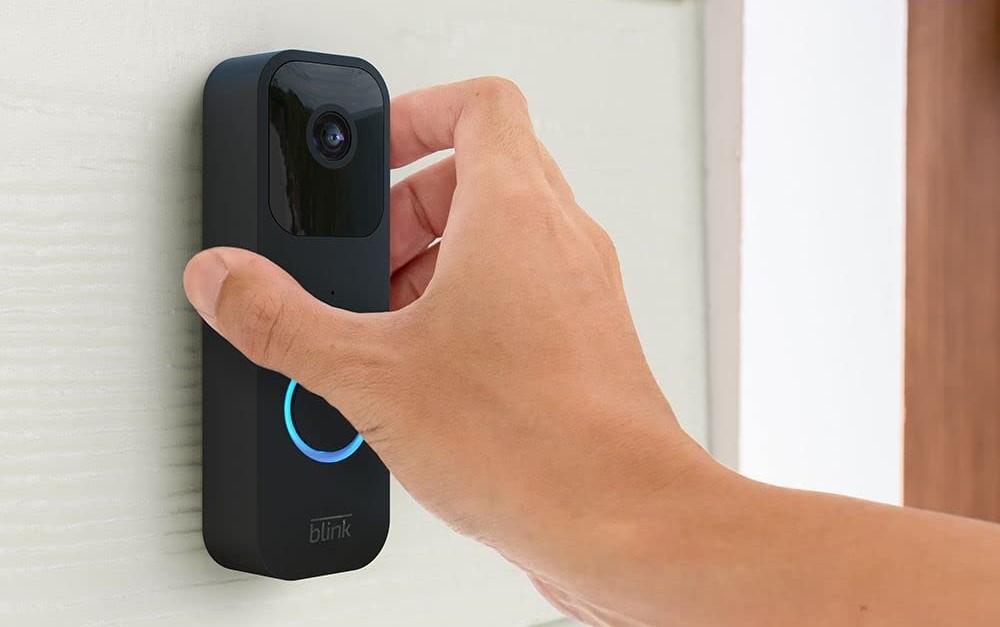Ring vs Blink: Which home security brand is best for your home?
Feel safe and secure in your decision

Video: 1536p HD+ video, Live View, Color Night Vision
Motion Detection: Advanced Motion Detection with Customizable Motion Zones
Field of View: 150 degrees horizontal, 150 degrees vertical
Audio: Two-way audio with noise cancellation
Power: Rechargeable Battery
The head-to-toe video capabilities along with the crystal clear HD footage make the Ring Video Doorbell an ideal option for those who want to protect their deliveries, and also get a good view of who is coming and going. With a rechargeable battery, the installation only takes a couple minutes.
The app is convenient to use as well and stores a handful of useful features like motion detection customization, so your phone doesn’t blow up with notifications from every person walking their dog or every car that drives by your front door. But to gain full access to all of the features, you’ll have to pay for a monthly subscription to Ring Protect starting at $4 a month.
Pros
- Easy to install
- Head-to-toe camera view
- Clear camera footage
Cons
- Requires subscription for recorded video history

Video: 1080p HD video
Connection: Battery or Wired
Field of View: 135 degrees horizontal, 80 degrees vertical
Audio: Two-way audio
Power: 2 AA non-rechargeable batteries or continuous power with wired option
If you choose to go the wireless route, the battery powered Blink option is a great combination of affordability and simplicity, especially installation. You basically stick it to a flat surface outside your door, run through the app prompts, and in under five minutes you have an operational video doorbell camera. You also have the option to use your existing doorbell wiring for continuous power, and to use your existing chime.
You have two options when it comes to sharing and storing video. If you’re not a fan of cloud storage, you can purchase the Sync Module 2 separately which allows you to save your clips locally via USB flash drive. You can also pay for a Blink Subscription Plan for cloud storage which starts at $3 a month.
Pros
- Affordable
- Easy to install
- Battery powered or wired options
Cons
- Batteries non-rechargeable
When it comes to home security, the debate between the best system to have for your home often comes down to Ring vs Blink. Both of them offer some of the best video doorbells available, but which brand comes out on top for the whole home?
Home burglaries are a common occurrence. In fact, there are roughly two burglaries in the United States every minute. While that statistic sounds alarming (no pun intended), home burglaries are on the decline. According to FBI data, burglaries have declined 62% since 2012. Part of that decline is the emphasis on simple home security measures that every homeowner can take, like video doorbells and home security cameras. Two of the most popular home security companies are Ring and Blink, and are readily available on Amazon and across the internet.
Ring is the most recognizable name in the DIY home security arena, and for good reason, it’s owned and powered by the Amazon mega-machine. Ring has a full offering of home security devices ranging from several video doorbell options to a full fledged home security system complete with cameras, sensors, and even 24/7 professional monitoring. And if you already have other Amazon devices in your home, like an Amazon Echo, you can sync your entire smart home setup to control everything from your TV to your home security system with your voice.
Blink is also an Amazon company, but with offerings more on a microscale compared to Ring. Blink is essentially the more affordable path compared to Ring, and is becoming a popular option among first-time home security buyers. Blink doesn’t have as many home security products as Ring, but the simple, yet affordable product line is the selling point. For instance, there are currently eight available Ring video doorbells for purchase. Blink only has one option. It’s half the price of the cheapest Ring video doorbell, and much less costly than most of the other Ring options.
Of course, there are other differences between the two home security vendors that go beyond price point. We’re here to shine a light on both home security companies, compare their product offerings, and give you all the information you need to decide which home security system is best for your needs.
Ring vs Blink: Design
Starting with indoor cameras, the Blink Mini is slightly smaller in size than the Ring Indoor Camera, but the differences are rather negligible (we’re talking tenths of inches by comparison). Both come with a stand that can be placed on a flat tabletop surface or be mounted. Both also have a ball joint base to help you position the camera where you need it. Both indoor cameras require power and are not battery operated. The Ring Indoor Camera has a better field of view with 143 degrees diagonal, while the Blink only sports 110 degrees diagonal.
The Ring Video Doorbell Plus is 5.1 in x 2.4 in x 1.1 in, while the Blink Video Doorbell is 5.1 in x 1.6 in x 1.3 in; both nearly identical in size with exception that the Blink Video Doorbell is a tidbit slimmer. The Ring Video Doorbell is available in a satin nickel finish while the Blink Video Doorbell is available in both black and white. Both have similar looks with a camera located on top and an illuminated blue circle surrounding the doorbell. And as we mentioned earlier, the Blink Video Doorbell is battery powered with non-rechargeable batteries, and also has a wired option for continuous power, while the Ring Video Doorbell Plus offers rechargeable batteries.
Sign up to receive the latest news, reviews, buying guides and deals direct to your inbox
Blink and Ring both offer up floodlight cameras and both are available in black and white. The Blink floodlight camera is battery powered and has two years' worth of battery life. The Ring Floodlight Cam Wired Plus is a wired option, so installation will require more time and effort (and for you to turn your power off to that area of the house during installation). The Ring Floodlight shines brighter with 2,000 lumens of light compared to Blink’s 700 lumens. And both feature 1080p video quality.

Ring vs Blink: Performance
Ring has a leg up on all three products in terms of performance. For their respective indoor cameras, the field of view is wider in the Ring Indoor camera at 143 degrees compared to the 110 degree field of view of the Blink. Ring covers more area, which means fewer blind spots in your indoor coverage, and less need for a secondary camera. The video quality is more or less the same from the two at 1080p, but the Ring camera does offer color night vision, which provides more detail and clarity when filming at night. In both Blink and Ring’s app, you can create customizable motion zones so you don’t get inundated with useless notifications.
For video doorbells, Ring, again, has more coverage. I currently have a Ring Video Doorbell Plus installed on my front door, and there is head-to-toe coverage of the porch, as well as coverage from each end of the sidewalk. I can essentially see anybody that steps on the sidewalk where my house is. Head-to-toe coverage is not a luxury you’ll find on the Blink Doorbell Cam. The vertical coverage stops at 90 degrees where the Ring offers 150 degrees of vertical coverage. Essentially a package is dropped off on your porch with the Blink Camera installed, you might not be able to see the package after it gets dropped off, and there’d be no way to tell if it's still there, if you aren’t home to bring it in.
The video quality is also better with the Ring doorbell. With the Ring Video Doorbell Plus, you get 1536p compared to 1080p from the Blink Doorbell. When it comes to installation, it’s sixes if you opt for the battery powered version of each. Each video doorbell should only take you a few minutes to install, which, of course, is part of the allure of owning a video doorbell.
Ring, yet again, is the better performer when it comes to their floodlight offerings. Ring provides a brighter floodlight compared to Blink. Ring’s shines at 2,000 lumens compared to Blink’s 700 lumens. The video quality for both is the same at 1080p a piece, but Ring’s field of view is slightly better than Blink’s at 140 degrees compared to 110 degrees, respectively.
The big outlier here is installation. The battery-powered offering from Blink is a much less involved installation process compared to Ring’s. Since the Ring Floodlight is a wired operation, you’ll need to remove an existing floodlight, or run new wiring to the place you want to install it. So, if you’re looking for an easy installation above all else, consider Blink over Ring when it comes to floodlights.

Ring vs Blink: Features
When it comes to features, Ring easily takes the cake over Blink. Performance and features is what the extra moola pays for when comparing products within these two brands.
As I’ve already explained in previous sections, the field of view is better with the Ring Indoor Camera. Also, color night vision is a plus, as you get better night time video quality compared to the Blink Indoor Camera. The Ring Indoor camera also has a feature called Privacy Zones, where you can tell the camera not to record certain parts. Like if your camera partially looks out into your neighbor’s yard, you can have the camera not record that area to preserve privacy. The Ring Indoor camera also has a privacy shutter that disables the camera and the microphone with a physical cover. All of these features are found only on Ring and not on Blink Mini.
Aside from the better head-to-toe field of view the Ring Doorbell provides over the Blink, the Ring Doorbell also has better alerts and notifications, as well as features like Quick Replies that aren’t available with Blink. The Ring Battery Doorbell Plus has package alerts that lets you know when a package has been received. Also, if you’re unavailable to answer your doorbell, quick replies is a handy feature where your doorbell essentially plays an automated message to let your visitor know you’re unavailable. Both of these features require a subscription to Ring Protect though. Outside of voice control with Alexa, (which Ring can do, too), there aren’t really any standout features with Blink compared to Ring.
A useful security feature found on the Ring Floodlight is the siren. This helps deter intruders beyond the motion light. The Blink Floodlight doesn’t have an additional siren. The Blink Floodlight does come with a Sync Module 2, meaning you can store video footage locally via USB, something you won’t be able to do with the Ring Floodlight. Both also work with Alexa, and feature two-way audio to talk to anyone or anything standing in front of the camera.

Ring vs Blink: Care & Maintenance
The nice thing about these security cameras from both Ring and Blink is that they are mostly set-it-and-forget-it. Both indoor cameras from each company are powered via a wall outlet connection, so no need to swap out batteries. You may want to wipe down the lens every few months so it doesn’t collect dust, but outside of that, the indoor cameras are rather low maintenance devices.
And outside of changing batteries (when applicable) the same goes for video doorbells and floodlights. They are built to be outside and withstand the weather. One thing that is worth mentioning, I have noticed with multiple video doorbells (not just Ring or Blink) that when exposed to especially cold weather (Utah winters get cold and snowy), the batteries tend to drain quicker due to cold conditions. Be prepared to charge or change out batteries on your devices more often than the manufacturer states (if you live in a cold weather climate).
Ring vs Blink: Price & Availability
Reviews
Whirlpool 24" Stainless Steel AI Dishwasher Review
Napoleon TravelQ PRO285 Portable Gas Grill review
Dreame L40 Ultra Robot Vacuum Cleaner and Mop review: almost hands-free cleaning
GE Profile Smart Mixer with Auto Sense review: a powerful, thorough mixer
Echo eForce DPB-2500 review: a leaf blower as a snow removal tool?
DPAS-2100 + Pro Paddle Attachment review: a new way to remove snow this winter?
Midea MAD53109APK 5.5QT Air Fryer review: a small, simple, and highly effective option
Eureka J15 Pro Ultra Robot Vacuum review: hands-free cleaning for busy families
If you’re a bargain hunter, Blink unequivocally is the winner here. All Blink products are much more affordable compared to Rings. Here’s a quick breakdown of the products we’ve mentioned, their price and where you can find them.
Ring Cameras
- Ring Indoor Cam - $59.99 at Amazon
- Ring Doorbell Plus - $179.99 at Ring.com and Amazon
- Ring Floodlight Cam Wired Plus - $199.99 at Ring.com and Amazon
Blink Cameras
- Blink Mini - $34.99 at Amazon
- Blink Video Doorbell - $59.99 at Best Buy and Amazon
- Blink Floodlight Camera - $139.98 at Amazon
Ring vs Blink: Our verdict
This boils down to what you value more - features or price tag. If you don’t need a fully integrated security system with a ton of features, you can save a lot of money going with Blink equipment. The floodlights aren’t as bright, the field of view isn’t as wide, and the features lack compared to Ring’s offerings, but the price for home security equipment is often too good of a bargain to ignore.
On the other hand, Ring has far more security system offerings, and with better features. Extras like wider field of views, head-to-toe range and smart notifications, like package detection for instance, better protect your property. Overall, Ring is the better choice for robust home security, but Blink is still a viable option for bargain hunters.

With a Bachelor's Degree in Communications and Media from Weber State University, Jonathan Knoder is all about Smart Home and AV tech. He currently works as a Content Manager for AvantGuard Monitoring Centers in Utah. Jonathan has written extensively and at great length about yard care and snow blowers for Top Ten Reviews, and this is his subject area.
